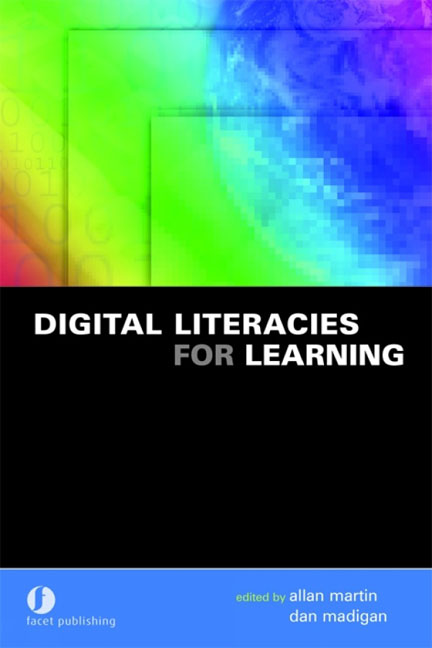Book contents
- Frontmatter
- Contents
- Dedication
- The contributors
- Foreword
- Preface
- Part I Literacies in the digital age
- 1 Literacies for the digital age: preview of Part 1
- 2 Learners, learning literacy and the pedagogy of e-learning
- 3 Real learning in virtual environments
- 4 Digital fusion: defining the intersection of content and communications
- 5 Literacy and the digital knowledge revolution
- 6 Understanding e-literacy
- 7 Information literacy – an overview
- 8 Contemporary literacy – the three Es
- 9 Reconceptualizing media literacy for the digital age
- 10 Literacy, e-literacy and multiliteracies: meeting the challenges of teaching online
- 11 Graduate e-literacies and employability
- Part II Enabling and supporting digital literacies
- Index
7 - Information literacy – an overview
from Part I - Literacies in the digital age
Published online by Cambridge University Press: 08 June 2018
- Frontmatter
- Contents
- Dedication
- The contributors
- Foreword
- Preface
- Part I Literacies in the digital age
- 1 Literacies for the digital age: preview of Part 1
- 2 Learners, learning literacy and the pedagogy of e-learning
- 3 Real learning in virtual environments
- 4 Digital fusion: defining the intersection of content and communications
- 5 Literacy and the digital knowledge revolution
- 6 Understanding e-literacy
- 7 Information literacy – an overview
- 8 Contemporary literacy – the three Es
- 9 Reconceptualizing media literacy for the digital age
- 10 Literacy, e-literacy and multiliteracies: meeting the challenges of teaching online
- 11 Graduate e-literacies and employability
- Part II Enabling and supporting digital literacies
- Index
Summary
Abstract
This chapter aims to present an overview of the multifaceted concept of information literacy. It should be seen as an exploration of ways of comprehending information literacy. The main questions are: what are the dominating ways of seeing information literacy and why is there an information-literacy initiative? Many authors rightly claim that the task of educating information-literate students and people is not the responsibility of one single group or profession, and consequently this chapter also looks at collaborative aspects of information-literacy education. In accordance with the scope of this book the chapter also presents information literacy in the light of other literacies.
Introduction
That information literacy is of great interest to many is evident by the amount of publications that relate to the concept (see Rader, 2002). Among its advocates one group dominates, namely librarians, which is apparent by the number of contributions to the literature made by library professionals. Despite the fact that the term ‘information literacy’ is said to have been coined in the early 1970s (Carbo, 1997), it is evident that the pedagogical ambition which goes along with information literacy education was recognized by librarians long before that:
A librarian should be more than a keeper of books; he should be an educator…. All
that is taught in college amounts to very little; but if we can send students out self-reliant
in their investigations, we have accomplished very much.
(Robinson, 1876)Ways of comprehending information literacy
When reviewing a number of documents with the common aim of defining or presenting an overview of the concept of information literacy (see e.g. Owusu- Ansah, 2003; Kapitzke, 2003) it becomes apparent that it is a concept that is often similarly regarded. Definitions and models, with slight variations, continuously appear, often in the form of lists that easily remind the reader of recipes or panaceas. The most widely spread of them all is formulated by the American Library Association (1989, 1):
To be information literate, a person must be able to recognise when information is needed and have the ability to locate, evaluate, and use effectively the needed information.
Seemingly stemming from the above definition, lists of desired attributes and standardized descriptions of how an information-literate student (or person) should behave or function have been developed.
- Type
- Chapter
- Information
- Digital Literacies for Learning , pp. 80 - 88Publisher: FacetPrint publication year: 2006
- 1
- Cited by



